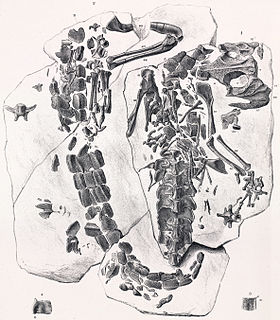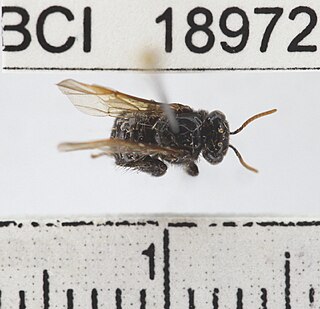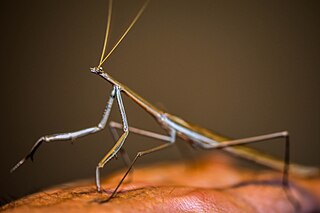
Eremiaphilidae is a small Old World family of praying mantids, based on the type genus Eremiaphila. As part of a major revision of mantid taxonomy, this family now contains the subfamily Tarachodinae, which includes tribes and genera previously placed in the now obsolete Tarachodidae.
Lisboasaurus is a small genus of Mesozoic crocodylomorph that lived in fresh water. It is known from fossilized tooth and jaw fragments of Late Jurassic and Early Cretaceous age. Two species have been described. In the past Lisboasaurus has been interpreted as an avialan, troodontid, or an anguimorph lizard. Both species are currently assigned to Crocodylomorpha, one is reassigned to the genus Lusitanisuchus.

Pareiasaurus is an extinct genus of pareiasauromorph reptile from the Permian period. It was a typical member of its family, the pareiasaurids, which take their name from this genus.

The rusty-spotted genet, also called panther genet and large-spotted genet, is a genet that is widely distributed in sub-Saharan Africa. It is considered common and therefore listed as Least Concern on the IUCN Red List.
Hyposaurus is a genus of extinct marine dyrosaurid crocodyliform. Fossils have been found in Paleocene aged rocks of the Iullemmeden Basin in West Africa, Campanian–Maastrichtian Shendi Formation of Sudan and Maastrichtian through Danian strata in New Jersey, Alabama and South Carolina. Isolated teeth comparable to Hyposaurus have also been found in Thanetian strata of Virginia. It was related to Dyrosaurus, and is the only dyrosaurid known from the western hemisphere. The priority of the species H. rogersii has been debated, however there is no sound basis for the recognition of more than one species from North America. The other North American species are therefore considered nomina vanum.

Melipona is a genus of stingless bees, widespread in warm areas of the Neotropics, from Sinaloa and Tamaulipas (México) to Tucumán and Misiones (Argentina). About 70 species are known. The largest producer of honey from Melipona bees in Mexico is in the state of Yucatán where bees are studied at an interactive park called "Bee Planet" which is within the Cuxtal Ecological Reserve.

Silvanidae, "silvan flat bark beetles", is a family of beetles in the superfamily Cucujoidea, consisting of 68 described genera and about 500 described species. The family is represented on all continents except Antarctica, and is most diverse at both the generic and species levels in the Old World tropics.

Theriosuchus is an extinct genus of atoposaurid mesoeucrocodylian from Late Jurassic to Early Cretaceous of Europe, Southeast Asia (Thailand) and western North America (Wyoming), with fragmentary records from Middle Jurassic and Early Cretaceous sites in China, Morocco, and Scotland.

Lemurs were first classified in 1758 by Carl Linnaeus, and the taxonomy remains controversial today, with approximately 70 to 100 species and subspecies recognized, depending on how the term "species" is defined. Having undergone their own independent evolution on Madagascar, lemurs have diversified to fill many ecological niches normally filled by other types of mammals. They include the smallest primates in the world, and once included some of the largest. Since the arrival of humans approximately 2,000 years ago, lemurs have become restricted to 10% of the island, or approximately 60,000 square kilometers (23,000 sq mi), and many face extinction. Concerns over lemur conservation have affected lemur taxonomy, since distinct species receive increased conservation attention compared to subspecies.

Kaatedocus is a genus of diplodocine flagellicaudatan sauropod known from the middle Late Jurassic of northern Wyoming, United States. It is known from well-preserved skull and cervical vertebrae which were collected in the lower part of the Morrison Formation. The type and only species is Kaatedocus siberi, described in 2012 by Emanuel Tschopp and Octávio Mateus.

Miomantinae is the larger subfamily of insects in the new (2019) family Miomantidae of order Mantodea. As part of a major revision of mantid taxonomy; an additional subfamily Solygiinae contains the sole genus Solygia and the tribe Rivetinini has essentially been elevated to family Rivetinidae. A number of genera have also been transferred from here to the Hierodulinae.

Tetragonula is a genus of stingless bees. In 1961, Brazilian bee expert, Professor J.S. Moure, first proposed the genus name Tetragonula to improve the classification system by dividing the large genus Trigona stingless bees into 9 smaller groups. About 30 stingless bee species formerly placed in the genus Trigona are now placed in the genus Tetragonula. These bees are found in Oceania, in countries such as Australia, Indonesia, New Guinea, Malaysia, Thailand, the Philippines, India, Sri Lanka, and The Solomon Islands. The most recent tabulation of species listed 31 species.

Knoetschkesuchus is a genus of small atoposaurid crocodylomorph from the Late Jurassic of Germany and Portugal. Two species are known: the German species K. langenbergensis, described by Schwarz and colleagues in 2017 based on two partial skeletons and various isolated bones; and the Portuguese species K. guimarotae, named from over 400 specimens including several partial skeletons. Knoetschkesuchus was a small and short-snouted crocodilian, measuring about 55 centimetres (22 in) in length, that primarily fed on small prey, including invertebrates, amphibians, and mammals. This specialization towards small prey ecologically separated Knoetschkesuchus from most of the other diverse crocodilians that it lived with in the island ecosystem of Jurassic Europe.

Homalictus is a subgenus of bees in the genus Lasioglossum subfamily Halictinae of the family Halictidae. They are found in Sri Lanka, Southeast Asia, east across the Pacific to the Mariana Islands, Samoa, Fiji and are most prevalent in Australia.
Wamweracaudia is a large herbivorous sauropod dinosaur from the Late Jurassic Tendaguru Formation of Tanzania, Africa, 155-145 million years ago.

Partamona is a genus of Meliponini in appended hymenoptera of the Apidae family. Herbert Ferlando Schwarz in 1938 described the genus. The genus is found in Sonora, Chihuahua, San Luis Potosí, in Mexico, Mato Grosso in Brazil, and eastern Peru.
Amanzia is a genus of turiasaurian sauropod dinosaur from the Reuchenette Formation in Moutier, Switzerland. The type and only species is Amanzia greppini, originally named as a species of Ornithopsis and Cetiosauriscus.

The Hierodulinae are a subfamily of praying mantids, originally used by Brunner von Wattenwyl. It was restored as part of a major revision of mantid taxonomy, and now contains genera previously placed elsewhere in the family Mantidae.

The Gonypetidae are a new (2019) family of praying mantids, based on the type genus Gonypeta. The first use of "Gonypetidae" was by Westwood and it has been revived as part of a major revision of mantid taxonomy; the subfamily Iridopteryginae having been moved here from the obsolete family Iridopterygidae. The Gonypetinae include Asian genera transferred from the obsolete taxa Amelinae and Liturgusidae.

Hoplocoryphidae is a newly erected (2019) family of praying mantids, based on the type genus Hoplocorypha. As part of a major revision of mantid taxonomy, genera have been moved here from the subfamily Hoplocoryphinae of the previously polyphyletic family Thespidae. The family Hoplocoryphidae is the only member of superfamily Hoplocoryphoidea. Species in this family have been recorded from tropical Africa.















